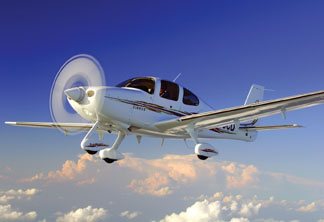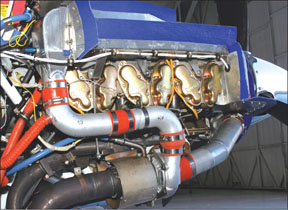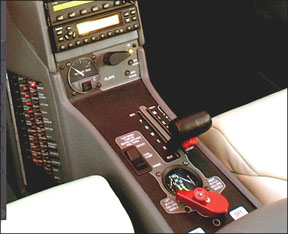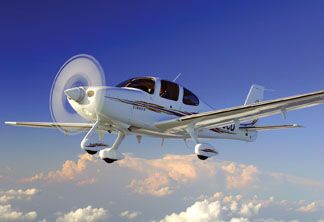
by Marc Cook
Weve been complaining about the lack of new products in general aviation for so long that we may not have noticed the full-on rivalry between two of the newest players: Cirrus and Columbia (ne Lancair Certified). Cirrus got the jump on Columbia and has many more aircraft flying. But the Cirrus lineup is devoid of the one thing that really kicked the sales charts off the filing cabinet in the good old days of the 1970s: a turbocharged model.
Sure, the SR22 has a lot more beans than the original SR20, and for pilots who routinely fly flatter terrain, the IO-550-powered SR-22 has sufficient low-altitude climb and very good performance. But there are always owners who want more-altitude capability, speed, flexibility, what have you. For these buyers, and particularly for those living in mountainous areas, a turbocharged model holds a lot of promise.
And if youre looking at a new plastic airplane, the simple fact is that Columbia has a turbo model and Cirrus does not. Not for long, though. The sharp-pencil types at Tornado Alley Turbo-the offshoot of General Aviation Modifications, Inc.-who have continued to tweak on the after-market turbo-normalizing system for Bonanzas and Cessna 185s, have turned their nerdy gaze toward the Cirrus SR22. Right now, the company is flying an SR22 fitted with an otherwise stock Continental IO-550-N given deep-breathing exercises thanks to a pair of Garrett T04 turbos that would normally be found under a Malibus cowling.
Like Tornado Alleys other products, this installation is turbonormalized, which is a fancy way of saying that the engines standard 8.5 to 1 compression ratio remains and boost is limited to 30 inches of manifold pressure. Maximum output remains at 310 horsepower, but that can be maintained to very high altitude. (Just how high, TAT doesnt know yet, but expects 100 percent power up to 20,000 feet at least.)
The benefits of turbonormalizing include better fuel efficiency compared to a normal ground-boosted turbo system. The peril is that detonation margins are potentially slimmer. But TAT emphasizes here, as it does with its Bonanza systems, that sufficient fuel flow on takeoff combined with efficient intercoolers, the chances of an actual detonation event are remote. Whats more-as you should expect from TAT-the expected operating mode will be lean-of-peak at all times in cruise.
Under the Cowl
Well get to the performance in a moment, but its worth looking under the cowl. The TAT SR22 looks remarkably unviolated. The twin turbochargers reside behind and be-low the engine. The two-blower route was chosen partly for packaging and partly so that the system has plenty of reserve. In fact, the prototype was fitted with cabin heating courtesy of compressor bleed air; this set-up would eliminate the traditional heat muff wrapped around an exhaust pipe and the concomitant risk of carbon-monoxide intrusion into the cabin.
Those two turbos are controlled by a fixed-point automatic wastegate system with a single actuator. A clever crossover linkage makes the dual wastegates play in synch. Not only does this configuration reduce the number of parts and costs, it eliminates a common problem in dual-turbo installations of getting different controllers and wastegates to work in harmony. With this arrangement, there’s one controller and its the boss.
Such maintenance-conscious engineering pervades the design. Induction air is taken from a horseshoe-shaped filter fitted just behind the prop spinner, where it is inherently protected from ice and other FOD. From there, inlet air runs down below the front cylinders in pipes made mostly from aluminum tube-with selected rubber connector pieces-that are fitted with automatic alternate-air doors that swing open and admit warm air from beneath the engine should the main filter become clogged.
From the turbochargers, induction air rises straight up behind the engine to twin intercoolers designed specifically for this installation. Theyre large and efficient, which is a key component in making a turbo system perform well.
At one point during our test flight, while in climb, the intercoolers knocked down compressor discharge temperature from 192 degrees F to 116 degrees going into the engine. In high-speed cruise at 17,500 feet on a slightly warmer-than-standard day, we saw induction temps of 92 degrees F.But more than that, the intercoolers are mounted to the upper baffle plate in such a way that they can be removed for excellent maintenance access to the topside of the engine. Cool cowling plenum air goes in topside and is exhausted just outboard of the rearmost cylinders on each side. The baffling is split with the intercoolers, so removing them to gain access to the engine requires pulling the flexible couplers and unscrewing the supporting baffle structure. Its easier done than said.
Tornado Alley Turbo paid attention to the turbo ducting in more ways than youd think. Sure, its as straight and direct as it can be, with a minimum of folding back on itself. (Every extra turn adds some restriction.) But a couple of extra turns per side were deemed necessary: Those induction tubes between the intercooler and the wye just ahead of the throttle body-remember, this is a top-down induction set-up-make an inverted U shape so that they are just barely visible in the standard Cirrus cowl openings. Improved aesthetics are fine but the real reason is to prevent masking cooling airflow to the cylinders.

Generally, the Cirrus cowling is unmodified from stock form despite concealing a lot more hardware. The inlets are totally standard as are the dual turbo outlets that fall right into the SR22s normal exhaust tunnels. To help improve extraction, TAT has fitted the prototype with a simple stainless-steel scoop directly behind the nosegear strut that increases exit area with a minimal drag penalty; in fact, when viewed from straight ahead, the gear strut neatly conceals the tunnel.
To further head off the deleterious effects of heat, TAT has strategically shielded and insulated various components under the cowling-including the cowling itself. TATs chief engineer, George Braly, found that the standard Cirrus cowling ran quite cool under the standard foil heat barrier. We figured it was mostly infrared heating, he says. So TAT just extended the insulation to cover nearly the entire lower cowling on the inside. After a flight, you can place a hand on the cowling adjacent to either turbo and hold it there.
Performance
So much for the nuts and bolts. In every respect, the TAT Cirrus enjoys the same gains in performance and efficiency that the Bonanzas do. One of the early knocks on turbo modifications was a loss of sea-level performance. The TAT SR22 doesnt show a bit of that problem. With two big boys aboard and nearly full fuel, we were within 100 pounds of the SR22s standard maximum-gross weight. (TAT is keeping a gross-weight increase in mind, but will concentrate on certifying the turbo package first.)
And yet, the SR22 shot off the blocks with all the back-tingling thrust you expect from 310 HP. Using half flaps-the normal procedure for an SR22 departure-the prototype accelerated smartly and charged into the sky at more than 1400 FPM at 85 KIAS. The deck angle was steep enough to be uncomfortable for pilots accustomed to seeing some horizon over the nose. Pushed over to 120 KIAS, the TAT SR22 gathered itself up and climbed at a steady and sustained 1500 FPM. Thats genuinely impressive performance at a comfortable deck angle.
Oh, the power setting? Typical TAT doctrine: Full throttle (30 inches down low, tapering just a bit to 29 inches at higher altitudes due to a slightly maladjusted controller), 2600 RPM and full rich to the tune of 35 GPH. Braly says that the target speed seems to be between 115 and 120 KIAS down low with a transition up to a 130-knot climb speed higher to help keep CHTs in control. Through 10,000 feet, which came surprisingly soon, the hottest CHT was 366 degrees, with EGTs in the high 1200s. Oil temperature was around 190 degrees for most of the climb.
Thinner air eventually takes its toll and the turbo-SR22 pilot will have to nose over slightly to keep the desired generous CHT margins. Climbing through 16,000 feet, the Cirrus needed 130 KIAS to maintain a 380-degree max CHT and climb rate had decayed to 900 FPM. (Like thats such a sacrifice.) The fuel flow had dropped slightly to 33.2 GPH.
Braly noted that the slightly reduced manifold pressure on the prototype at this altitude, 28.7 inches, cost approximately 300 FPM in climb rate. The prototype ran extremely we’ll with very few squawks, chief among them this slight deterioration of manifold pressure with altitude and the prop governors unwillingness to spin up past 2650 RPM.
Finally, we set the cruise configuration, which is dramatically easy on this airplane. Pull the throttle/prop control back to 2500 RPM-the manifold pressure stays near 29 inches with the Avidyne showing a calculated percent of power at 106-and do the Big Mixture Pull to 17 GPH.
The engine transitions smoothly to lean-of-peak operation and you feel a slight deceleration in the airplane, although not as much as youd expect, given the drop in fuel flow. Youre done. Watch the CHTs and use the mixture control to fine tune them.
This near-standard day saw the hottest cylinder hover around 380 degrees. A later flight at 11,500 feet using 2600 RPM allowed us to use nearly 18 GPH to stick to the 380-degree limit. Think of the red lever as controlling both speed and CHT. When you want more speed, spend the fuel but watch the CHTs.To cool a hot cylinder, lean some more. After a suitably long period to let the airspeed stabilize, the Cirrus analog indicator sat just a hair below 150 knots, for a true airspeed of 205 knots. Braly thinks the indicator may be slightly optimistic, but a four-way speed run with GPS penciled out to 203 knots true. Later, at 11,500 feet, using 100 additional RPM and with the benefit of about an inch more boost, the SR22 scooted along at just under 200 knots on 18 GPH. lean of peak, of course.
Smooth, Efficient
Through it all, the big Continental seemed completely contented. It was as smooth as in any SR22; the temperatures were extraordinarily we’ll controlled; the efficiency gains of the speed at altitude make the most of the airplanes standard 84-gallon fuel capacity, with 81 gallons usable.
Braly and company have yet to explore the airplanes performance above 17,500 feet but expect the big turbos to have no trouble keeping up with the ever thinning atmosphere. The cooling modifications are planned to conquer the difficult climb-cooling test thats required for the Supplemental Type Certificate approval.

Downsides of the TAT treatment? Not many. The entire installation adds 75 pounds to the nose of the SR22, heft you can feel only during the landing flare, when you may get to bang the elevator up stops more than youre used to. (To be fair, a forward-loaded SR22 has no excess of elevator authority in the flare.) That is, of course, 75 pounds of people or fuel you have to leave behind.
Then there’s cost. TAT has not set a firm price, not unreasonable considering that certification isn’t expected for another three to six months, according to Braly. Still, he hints that the target is $50,000 to $55,000 including installation. Will you get one through TAT or from Cirrus?Braly says that we expect to discuss factory options with Cirrus when the project nears final certification. Cirrus appears to be one of the more enlightened OEMs in the aircraft world in this respect, so we will just have to wait and see how that goes.
What Braly doesnt brag about is that Cirrus has assisted the company with some key engineering data and is clearly not as adversarial as some other well-known OEM whose product benefits from TATs efforts. (Raytheon, you paying attention here?) Moreover, latching onto the TAT program makes all the sense in the world for Cirrus, whose line lacks a turbo model while its chief competitors deep-breathing model is by far the better seller of its two.
Whether the TAT system becomes a defacto factory option or just well-respected aftermarket modification remains to be seen. But this stands proud: The TAT SR22 dramatically closes the performance gap to the Columbia 400 and promises to be a good deal, relatively speaking. (The price Delta from the Columbia 350 to the 400 is a nice round $100,000.) Plus, a turbonormalized SR22 offers Cirrus faithful both an upgrade path-one thats we’ll worn given the number of SR20 owners who have traded for 22s-and heady performance for a fixed gear single.
Also With This Article
“Checklist”
“Speed, Efficiency, Range”
-Marc Cook is editor of Aviation Consumers sister magazine, KITPLANES.





